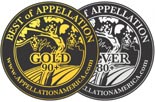
 The Willamette Valley has set an impressive standard for North American Pinot Noir, on par with the world’s best. If local winery owners have their way, consumers will soon crave not only Willamette Valley Pinot Noir, but also wines labeled from one of its many distinct sub-regions.
The Willamette Valley has set an impressive standard for North American Pinot Noir, on par with the world’s best. If local winery owners have their way, consumers will soon crave not only Willamette Valley Pinot Noir, but also wines labeled from one of its many distinct sub-regions.
Within the last two years the BATF has approved five new AVAs within the valley, with a sixth (the Chehalem Mountains) waiting in the wings. The approval of these AVAs helps consumers make more educated and stimulating purchasing decisions as the valley’s best growing regions are now clearly defined.
The 100-mile-long Willamette Valley is currently Oregon’s largest appellation. It encompasses 5,200 square miles and the bulk of the state’s wineries, which now number over 200. Flanked by the Coastal and Cascade mountains, this appellation has built its reputation on small, quality-oriented producers who are fervently devoted to Pinot Noir. The grape benefits from growing on a variety of hillside slopes and on a range of soils, created by volcanic activity and weathered sedimentary rocks. Increasingly, Pinot Gris is also grown, mostly in the foothills of the Coastal Range.
Willamette’s climate is generally considered cool and wet. This can be a misnomer, as most precipitation occurs outside the growing season. Winters are moderate and summers can be pleasantly warm. To learn more about the Willamette's distinct growing regions see our 'maps and more' section.
|
|
Current Feature
In the southern Blue Ridge Mountains of North Carolina and Georgia vineyards are small and few, yet the establishment of the Upper Hiwassee Highlands could bring much more.
[>] continue
Appellation Features
[>] see all Willamette Valley features (6)
Related Features
Best of Appellation
See the best wines of
Willamette Valley
Alive & Well here

Pinot Gris | Grigio:
You’ve earned top reviews working the stages of Alsace, where you are a local legend, even outshining
[>] continue
Correspondent
Barbara Trigg
is the Regional Correspondent for Willamette Valley.
 Defining the Regional Characteristics of Oregon Pinot Noir: An Interview with Ken Wright
By Rebecca Murphy
Defining the Regional Characteristics of Oregon Pinot Noir: An Interview with Ken Wright
By Rebecca Murphy The Oregon Chardonnay Alliance Makes a Case for Willamette Valley Chardonnay
By Rebecca Murphy
The Oregon Chardonnay Alliance Makes a Case for Willamette Valley Chardonnay
By Rebecca Murphy


 Bi-State Upper Hiwassee Highlands an AVA
Bi-State Upper Hiwassee Highlands an AVA  Willamette Valley: It's Not Just
Willamette Valley: It's Not Just  The Willamette Valley
The Willamette Valley Hitting the Sweet Spot
Hitting the Sweet Spot  Remote Manton Valley New California AVA
Remote Manton Valley New California AVA WAWGG Banquet Explores Washington State Terrior
WAWGG Banquet Explores Washington State Terrior Taking Focus on Appellation
Taking Focus on Appellation




